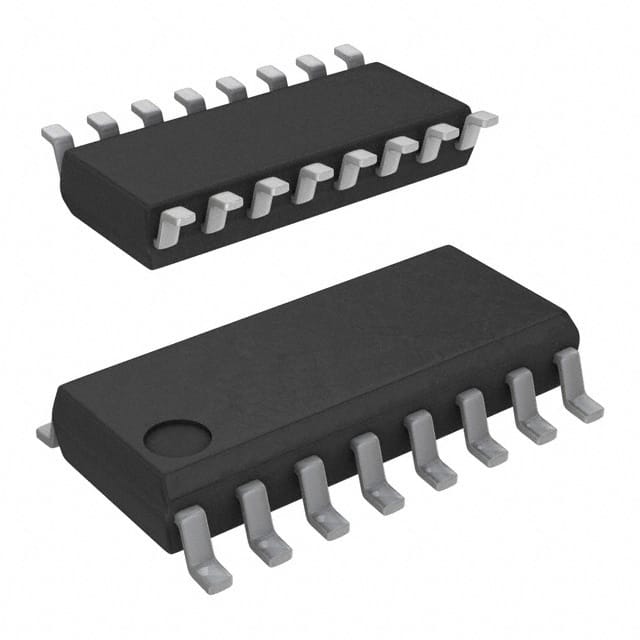Viz Specifikace pro podrobnosti o produktu.

CD4049UBDRE4
Product Overview
- Category: Integrated Circuit (IC)
- Use: Logic Inverter/Buffer
- Characteristics: High Voltage CMOS Hex Inverting Buffer/Converter
- Package: SOIC (Small Outline Integrated Circuit)
- Essence: Hex Inverter/Buffer with High Voltage Tolerant Inputs
- Packaging/Quantity: Tape and Reel, 2500 pieces per reel
Specifications
- Supply Voltage Range: 3V to 18V
- Logic Family: CMOS
- Number of Inputs: 6
- Number of Outputs: 6
- Propagation Delay: 60 ns (typical)
- Operating Temperature Range: -55°C to +125°C
Detailed Pin Configuration
The CD4049UBDRE4 has a total of 16 pins. The pin configuration is as follows:
- Pin 1: Input A (Inverter 1)
- Pin 2: Output Y (Inverter 1)
- Pin 3: Input B (Inverter 2)
- Pin 4: Output Y (Inverter 2)
- Pin 5: Input C (Inverter 3)
- Pin 6: Output Y (Inverter 3)
- Pin 7: VDD (Positive Power Supply)
- Pin 8: GND (Ground)
- Pin 9: Output Y (Inverter 4)
- Pin 10: Input D (Inverter 4)
- Pin 11: Output Y (Inverter 5)
- Pin 12: Input E (Inverter 5)
- Pin 13: Output Y (Inverter 6)
- Pin 14: Input F (Inverter 6)
- Pin 15: VSS (Negative Power Supply)
- Pin 16: Not Connected
Functional Features
- Hex inverting buffer with high voltage tolerant inputs
- Wide supply voltage range allows compatibility with various systems
- High noise immunity and low power consumption
- Can be used as a level shifter or logic converter
Advantages and Disadvantages
Advantages:
- High voltage tolerance makes it suitable for use in industrial applications
- Low power consumption helps in reducing overall system energy requirements
- Wide supply voltage range provides flexibility in different operating conditions
Disadvantages:
- Propagation delay may limit its use in high-speed applications
- Limited number of inputs and outputs restricts its application in complex circuits
Working Principles
The CD4049UBDRE4 is a CMOS-based hex inverter/buffer IC. It operates by taking the input signal and producing the inverted output signal. The high voltage tolerant inputs allow the IC to handle signals with higher voltage levels, making it suitable for industrial applications. The CMOS technology ensures low power consumption and high noise immunity.
Detailed Application Field Plans
The CD4049UBDRE4 can be used in various applications, including:
- Industrial control systems
- Power management circuits
- Level shifting and logic conversion
- Signal conditioning circuits
- Battery-powered devices
Detailed and Complete Alternative Models
Some alternative models that can be considered as replacements for the CD4049UBDRE4 are:
- CD4069UB - CMOS Hex Inverter
- SN74HC04 - Hex Inverter
- MC14069UB - CMOS Hex Inverter/Buffer
These alternatives offer similar functionality and characteristics, providing options for different design requirements.
Word count: 314 words
Seznam 10 běžných otázek a odpovědí souvisejících s aplikací CD4049UBDRE4 v technických řešeních
Sure! Here are 10 common questions and answers related to the application of CD4049UBDRE4 in technical solutions:
Q: What is CD4049UBDRE4? A: CD4049UBDRE4 is a hex inverter/buffer IC (integrated circuit) that can be used in various electronic applications.
Q: What is the operating voltage range for CD4049UBDRE4? A: The operating voltage range for CD4049UBDRE4 is typically between 3V and 18V.
Q: Can CD4049UBDRE4 be used as a level shifter? A: Yes, CD4049UBDRE4 can be used as a level shifter to convert signals between different voltage levels.
Q: How many inverters are there in CD4049UBDRE4? A: CD4049UBDRE4 contains six independent inverters.
Q: What is the maximum output current of CD4049UBDRE4? A: The maximum output current of CD4049UBDRE4 is typically around 6mA.
Q: Can CD4049UBDRE4 be used in high-speed applications? A: CD4049UBDRE4 is not specifically designed for high-speed applications, but it can be used in moderate-speed digital circuits.
Q: Is CD4049UBDRE4 suitable for use in low-power applications? A: Yes, CD4049UBDRE4 is known for its low power consumption, making it suitable for low-power applications.
Q: Can CD4049UBDRE4 be used in both digital and analog circuits? A: CD4049UBDRE4 is primarily designed for digital applications, but it can also be used in certain analog circuits.
Q: What is the typical propagation delay of CD4049UBDRE4? A: The typical propagation delay of CD4049UBDRE4 is around 20 ns.
Q: Can CD4049UBDRE4 tolerate electrostatic discharge (ESD)? A: Yes, CD4049UBDRE4 has built-in ESD protection, which allows it to withstand reasonable levels of electrostatic discharge.
Please note that these answers are general and may vary depending on specific datasheet specifications and application requirements.

